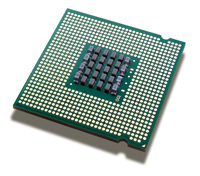Microprocessor
A microprocessor, sometimes called a logic chip is a computer processor or microchip. It incorporates the functions of a computer's central proccesing unit(CPU) on a single integrated circuit(IC).
It runs programmes from the operating system to the user applications; it runs the programmes' instructions in a low-level language, it performs arithmetic operations; such as add, subtract, multiply, divide, binary logic and memory accesses.
Microprocessor speed
The speed of a microprocessor depends on various factors: the number of instructions it processes, the bandwidth, and the clock speed. An instruction is a command that the Microprocessor executes. The bandwidth identifies the number of binary digits that the Microprocessor can proceed on its own order. The clock speed identifies the speed that the microprocessor processes an instruction.
The speed of microprocessor also depends on the number of the transistors built into the Processor. The transistors in the microprocessor improve the data signals on the processor. The Larger the number of transistors built on the microprocessor the faster is the speed of the Microprocessor.
Microprocessor frequency
Microprocessor frequency specifies the operating internal frequency of CPU's core. The higher the frequency is for a given CPU family, the faster the processor is.
The frequency is measured in Hertz and it can be also expressed in :
-Kilohertz (kHz), equals to 1,000 Hertz
-Megahertz (MHz), equals to 1,000,000 Hertz or 1,000 kHz
-Gigahertz (GHz), equals to 1,000,000,000 Hertz, or 1,000,000 kHz, or 1,000 MHz
Microprocessor word size
Microprocessor word size is the numbers of bits that a CPU can process at one time. Microprocessor have different word sizes usually powers of two (8, 16, 32, 64) that have predominated for many years. A microprocessor's word size is often equal to the width of its external data bus, but sometimes the bus is made narrower than the CPU to economise on packaging and circuit board costs.
